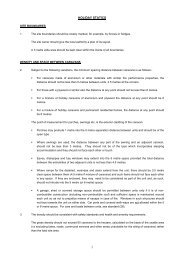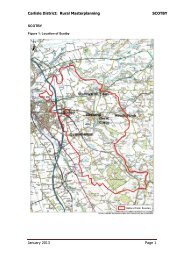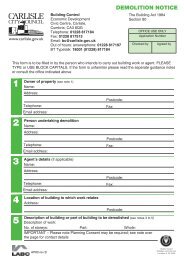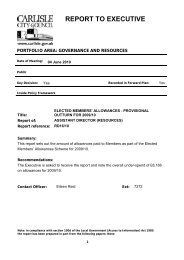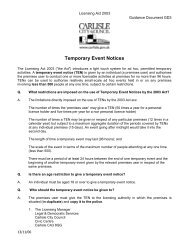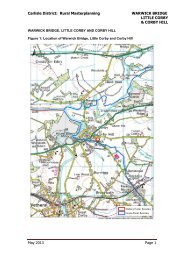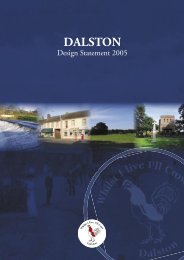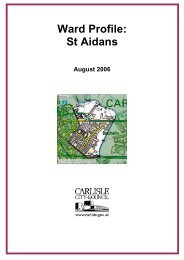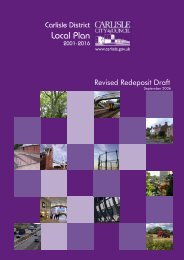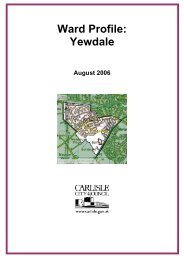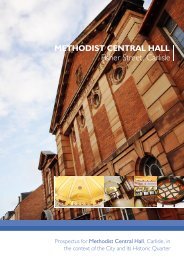Download the Management Plan - Carlisle City Council
Download the Management Plan - Carlisle City Council
Download the Management Plan - Carlisle City Council
Create successful ePaper yourself
Turn your PDF publications into a flip-book with our unique Google optimized e-Paper software.
Talkin Tarn is a 65 acre (26 hectares) natural Tarn, glacial formed approx 10,000 years ago. It is<br />
fed by two above ground inlet streams and it is believed also some underground springs although<br />
<strong>the</strong>re is little evidence to support this at present. A plan of water depths is located in <strong>the</strong> site<br />
office. Over time, work has been undertaken on a add hoc basis to encourage marginal<br />
vegetation. The biggest affect on this was <strong>the</strong> installation of a fence around <strong>the</strong> Tarn in 2002 to<br />
prevent livestock from grassing at <strong>the</strong> Tarn edges. The lack of subsequent poaching from<br />
livestock has allowed <strong>the</strong> vegetation to recover and spread. Some clumps of vegetation have<br />
been transplanted to speed up this process. In 2007 common reed was transplanted from Siddick<br />
Ponds in Workington with permission from Natural England and planted into wildlife bay. This<br />
has taken well and is now beginning to spread and <strong>the</strong> individual clumps join toge<strong>the</strong>r. The reed<br />
has also had <strong>the</strong> effect of protecting <strong>the</strong> bank from <strong>the</strong> wave wash. The bank has <strong>the</strong>n<br />
subsequently silted up and started to grow fur<strong>the</strong>r vegetation.<br />
Talkin Tarn was surveyed as part of <strong>the</strong> Cumbria Tarns Project (2003-2009), initiated by<br />
Cumbria Wildlife Trust (CWT) and <strong>the</strong> Freshwater Biological Association (FBA) as part of<br />
CWT’s Community Action for Wildlife programme. Aquatic macrophytes in Tarns are<br />
indicators of <strong>the</strong> health not only of <strong>the</strong> waters <strong>the</strong>mselves but also of <strong>the</strong>ir surrounding<br />
environment. The health of a freshwater body is directly related to <strong>the</strong> state of its catchment and<br />
this forms <strong>the</strong> basis for European legislation to protect freshwater systems, <strong>the</strong> Water Framework<br />
Directive (Directive 2000/60/EC).<br />
Canadian Pond Weed<br />
This weed was introduced from North America at <strong>the</strong> end of <strong>the</strong> 19th century and rapidly spread<br />
throughout <strong>the</strong> UK. It is a relatively common water plant in still waters in <strong>the</strong> UK. It can form<br />
dense banks of weed that will block waterways and can re-grow vegetatively from any small<br />
piece left after removal.<br />
This is a common sight on <strong>the</strong> Tarn and comes and goes each year in various quantities. It is an<br />
important food source for <strong>the</strong> wildfowl all year, but particularly in <strong>the</strong> winter when o<strong>the</strong>r food is<br />
scarce. It is disliked by human water users for getting in <strong>the</strong> way of paddles, propellers and<br />
rudders. The weed is only removed from areas urgently needing to be cleared for special events<br />
such as <strong>the</strong> large annual rowing regatta. After periods of strong wind and resulting wave action<br />
weed regularly washes up in <strong>the</strong> bays at <strong>the</strong> nor<strong>the</strong>rn end of <strong>the</strong> Tarn. This can become unsightly<br />
and smelly. This is removed by JCB at least twice a year (usually late autumn to remove leaf<br />
drop at same time) and at o<strong>the</strong>r times by staff and volunteers. Ideally this weed should be<br />
removed from site to try and reduce <strong>the</strong> nutrient levels in <strong>the</strong> Tarn which are adding to <strong>the</strong><br />
problems with blue green algae. Disturbing <strong>the</strong> weed through cutting and removal can break off<br />
many small plant parts that can <strong>the</strong>n re-grow potentially exacerbating <strong>the</strong> problem. Weed can<br />
potentially be taken to Willowholme for adding to councils green waste pile. This is removed<br />
twice/year by an approved green waste disposal company for <strong>the</strong> purpose of composting.<br />
However this may involve double handling of weed and is not currently viable.<br />
Action<br />
Investigate methods for stock piling weed and transporting by approved contractor for<br />
composting purposes.<br />
26



